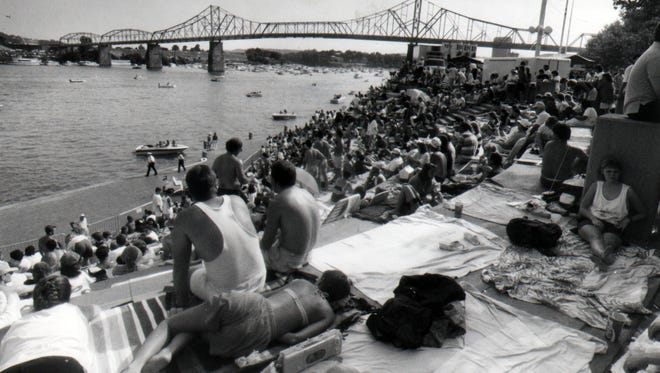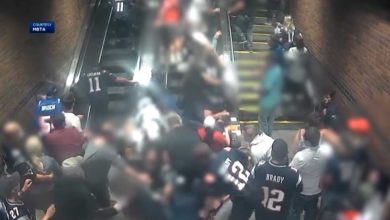

Note: This story was originally published Sept. 2, 2016.
It all began as a birthday party.
What is now called the Western & Southern/WEBN Fireworks at Riverfest started when radio station WEBN-FM celebrated 10 years on the air back in 1977. People had such a blast that on Sunday they will be doing it again for the 40th time.
The fireworks show was the brainchild of Frank “Bo” Wood Jr., WEBN’s general manager and president at the time.
“I thought it would be fun to have a birthday party for the whole city and do something they’ve never seen before,” Wood told the Enquirer in 1978. “Since we’re a radio station we decided to broadcast music to go with the display, multimedia fireworks. It worked beyond anyone’s expectations.”
That’s putting it mildly.
The station promoted the party on the air and in print ads in newspapers. And that was it.
The first fireworks show was held on Aug. 30, 1977 – a Tuesday night. There was no police traffic control, no parking at Riverfront Stadium. Crowds flooded both sides of the Ohio River.
“We had no idea that thousands would show up,” recalled former WEBN DJ Tom Sandman. “It was the height of FM radio. People responded to a free fireworks show and music by the river.”
DJ Glenn Gaskins produced a mix of song cues on reels loosely synchronized to the spectacular pyrotechnic show by Rozzi’s Famous Fireworks.
The whole city then got involved in a repeat the following year when the Cincinnati Symphony Orchestra held an all-day event along the river – and Riverfest was born.
The main attraction, of course, was the WEBN fireworks.

By the third year, Riverfest had become a Cincinnati tradition and the unofficial signal for the end of the summer.
“We didn’t have any of the sophisticated computer equipment fireworks companies now have,” said Sandman, who produced the soundtrack for the shows from 1980 to 1982.
By Sandman’s time, the music was cut into pieces and put onto numbered tape cartridges – called carts in the radio biz – that are similar to 8-track cartridges.
The music was a combination of rock, pop, movie soundtracks and classical – with a well-timed “Ribbit!” – all piped over the airwaves on WEBN 102.7 FM. If you wanted to hear the music, you had to bring your boom box to the river.
Sandman rated his first year’s show as “pretty good,” but the next year had problems. His final year, “we hit almost every one right on the nose,” he said.
The finale was the crescendo build-up at the end of the Beatles’ “A Day in the Life,” and the show left its biggest effect to hit on that famous last chord.
DUNnnnnnnn
When fireworks burst at the perfect moment to the music … “That was total luck,” said Jay Gilbert, a former ’EBN DJ who was contracted to produce the soundtracks in 1983 and ’84.
“The word ‘synchronized’ with fireworks was a myth until sometime in the 1990s,” he said.
Modern computer technology allows for microchips to be imbedded into the fireworks shells so a signal can be sent to explode them with perfect timing. Not so 30 years ago.
“There is no way of really knowing precisely how long any specific group of fireworks would take,” Gilbert said.
When asked how the process worked back then, he groaned: “I don’t even want to think about it. It was so insane.”

The Rozzis created a script of what fireworks there were going to be along with a brief description (this one will be busy and loud, this one elegant and slow) and an estimate of how long it would take each firework to explode, Gilbert explained.
Another 20-30 seconds was added to each musical segment just in case, and the segments were put on carts numbered to match the fireworks flights.
During the show, the Rozzis were on the barge sending off the fireworks manually. When they announced the next flight in 20 seconds, a WEBN staff member on the barge radioed to the producer at Master Control, which in those days was the deck of the Newport Yacht Club.
The producer had a walkie-talkie in one hand and a telephone directly to the WEBN studios in Hyde Park Square in the other to relay the message to fire off the next cart.
“All this is happening in deafening noise,” Gilbert said. “People are screaming at the fireworks, screaming into the phone. It was all that haphazard.”
They also prepared contingency carts in case there were any snafus.
“On the barge, thousands of fireworks go up in the air and explode and debris drops down and a lot of it is still burning,” Gilbert said, “and a spark might ignite a flight not ready for another 10 minutes.”

One year Gilbert was the staffer standing on the barge with the walkie-talkie. He was told to wear a hat and clothes he’d never wear again.
“It’s literally raining fire,” Gilbert said. “There was a guy behind me whose job it was to brush off ashes from my head and shoulders.”
The view of the fireworks directly over your head is amazing, but “it’s very, very loud,” he added.
Over the years, the fireworks shows have become bigger, better and more complex. Since crews have pulled it off for nearly four decades, it is easy to forget how much work and planning goes into each production.
Each year there are new challenges and obstacles. The show was first broadcast on television in 1984, and it hasn’t always gone off without a hitch. In 2011, WEBN inadvertently broadcast the previous year’s soundtrack for the first 12 minutes.
Still, these days the WEBN fireworks show isn’t nearly the seat-of-the-pants operation it was in the early years.
“It was a live mix of music,” Sandman said of the old way. “That does not happen anymore. It was a bygone era. It’s terrific when you can pull it off, frustrating when you can’t.”
Source link








